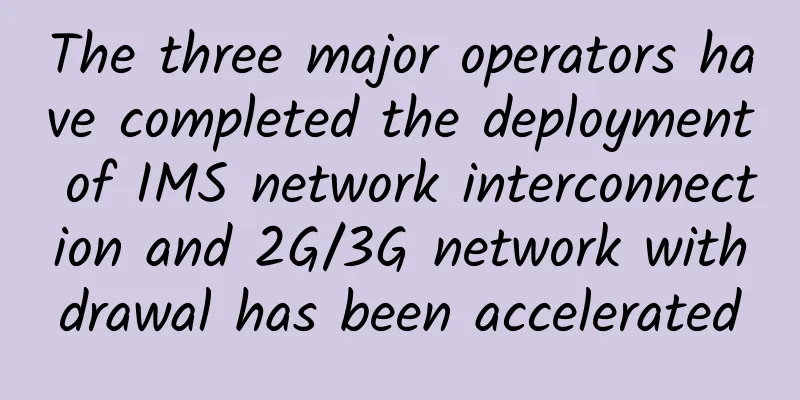Still don't understand router networking? You will understand after reading this article

|
As consumers' living standards improve, more and more people will choose to live in larger houses. However, after moving into a large house, the most troublesome problem is definitely the issue of Wi-Fi coverage. As we all know, because the power of a single router has an upper limit (national standard), the entire coverage range of the router is fixed in a certain sense. The farther away from the router, the worse the signal and the lower the speed. Not to mention that if there are walls or other obstructions, the signal attenuation will be even greater, so a router certainly cannot solve the problem of network coverage. In the past, the coverage problem was mainly solved by pulling network cables, that is, preparing multiple wireless routers, one as the main router, and the other routers connected to the main router, and then covering their respective areas. However, this method is undoubtedly unacceptable to some consumers who have high requirements for aesthetics and have not laid network cables in advance. In this context, router networking has become the choice of more and more consumers. Today, I will introduce to you the current mainstream networking methods so that you can understand the differences between these networking methods. Wireless BridgingWireless bridging is the process of connecting two users in different physical locations where wiring is inconvenient to connect to the same local area network, while also amplifying the signal. Wireless bridging mainly utilizes the WDS (Wireless Distribution System) function of the router. Although the coverage of a single wireless router is limited, there may be wireless blind spots or areas with weak signals in the local area network. However, the WDS bridging function can connect the wireless router to the existing signal wirelessly, thereby eliminating blind spots, extending the range and enabling mobile roaming. Therefore, two wireless devices can be used to establish a WDS trust and communication relationship between them to increase the signal coverage range and expand the wireless network coverage range to more than double the original. Generally speaking, in an ordinary home environment, only two router devices are needed to achieve wireless bridging. For the sake of convenience, the one being bridged is called the main router, and the one performing the bridging is called the slave router. It should be noted that, generally speaking, do not connect the master and slave routers with an Ethernet cable, and dual-band routers cannot simultaneously bridge the 2.4GHz and 5GHz bands; WDS bridging only needs to be set up on the slave router. Today's wireless routers' WDS wireless bridging functions are already very complete, and the operation steps are also very simple. We only need to click "Wireless Relay" in the network settings to enter the menu. The operation of wireless relay is as convenient as connecting to Wi-Fi using computers, mobile phones, tablets and other devices. Simply scan the network name (SSID) of the main router A on the bridge router B, then select the network name of the main router A, enter the correct password, and click Connect to complete the bridging work. Mesh NetworkingMesh networking is currently the most popular technology for solving home Wi-Fi coverage. It allows multiple routers to form a network and unify it into one network, so that wireless devices can switch seamlessly between multiple routers. Mesh networking is very suitable for situations where there are too many blocking walls at home. It is a magic tool for Wi-Fi signal coverage in large apartments, large flats, duplexes, and villas. Mesh networking is simple and convenient to set up, with automatic synchronization of configuration, and supports wired + wireless hybrid networking and network roaming. The same Wi-Fi name (i.e. the same SSID) can cover the entire house, and Internet-connected devices can automatically and seamlessly switch between different devices without any extra worries. Currently, Mesh networking generally supports three types: wired Mesh, wireless Mesh, and hybrid networking. Obviously, wired Mesh has the best effect. What needs to be noted here is that there should be as few walls as possible between the routers, with a maximum of one wall; at the same time, the routers should be placed so that there is no more than one wall in any part of the house, so that they can connect to a Mesh router. Of course, as an "upgraded version" of wireless relay technology, as long as you don't buy an entry-level router that costs just a few dozen dollars, it basically has this function. Moreover, you can set up a network through a mobile phone APP. Some manufacturers even have wireless Mesh networking packages. After purchasing this router, you can automatically set up a network. Just connect a router to an optical modem or network outlet, and other devices will automatically access the network, which is very convenient. AC controller + AP panel networkingFor users on multiple floors, the AC controller + AP panel solution is the most suitable. Each AP panel is installed on the wall like a socket. It is very simple and beautiful, and the presence of the router cannot be seen. The main router is placed in the distribution box, and the AP panel is used to replace the original network port, so that the signal can be switched seamlessly. Then the APs are powered by the network cable (PoE), and no additional power is required, making the layout and installation very convenient. But it should be noted that all devices must be directly connected through network cables, so the network cables must be pre-buried before decoration. In the early years, the AC+AP solution was mainly used in stations, large shopping malls, enterprises, hotels and other places with a large number of wireless terminal access. In recent years, Ubnt, Cisco, Ruckus, and Aruba have all had mature enterprise-level solutions, but they are expensive and complex in configuration, making them not very practical for home users. With the rapid development of Wi-Fi technology, the 5G band rate in Wi-Fi 6 has reached 1000Mbps, but the 5G band has a short transmission distance and weak wall penetration ability. Therefore, major manufacturers have also launched AC+AP Wi-Fi coverage solutions for home use. The AC+AP networking method is simple to set up. Now most commercial houses have pre-buried network cables from the low-voltage box to each room. In this case, the AC controller can be placed in the low-voltage box. If the AP is installed as a wall switch, the original network cable socket can be directly replaced with the AP. |
<<: Detailed explanation of the design points and principles of 6G system data governance solutions
Recommend
Storage requirements for reliable 5G gateways in industrial systems
Manufacturing and production are being revolution...
NETSCOUT's OneTouch AT G2 is your network testing nightmare
[51CTO.com original article] Xiao Nie just return...
SPI subsystem SPI spec
1.SPI hardware SPI: Serial Peripheral Interface, ...
China's Internet world under the epidemic is being "mirrored" around the world
DingTalk made its debut in Japan. "Well... t...
CrownCloud: AMD Ryzen series KVMs are now available in Los Angeles data center, starting at $5 per month
CrownCloud is a foreign VPS hosting company found...
Foreign media said that the number of 5G base stations in Shenzhen has exceeded that of Germany by 50 times
According to foreign media, Germany's Handels...
How to use big data well? Liu Jianhui of 51 Credit Card reveals the way to advance big data application products
[51CTO.com original article] The Global Software ...
Nexril: $9/quarter KVM-1GB/15G SSD/1TB/Dallas data center
Nexril is a site under Corex Solutions, LLC. It w...
Building a strong network nation, Inspur Cisco network helps government information construction
At the "Joining Inspur's Thinking and In...
The three major operators' Q1 2021 financial reports: revenue and profits both increased, and 5G drove performance back to prosperity
“Plant trees in spring and harvest fruits in autu...
Data center "cloudification" solves the embarrassment of virtualization
Virtualization technology is being used more and ...
It is necessary to draw a clear line between the capital push and capital speculation behind blockchain
In recent days, the most eye-catching and frequen...
Huawei aims to be a smart city incubator providing basic energy
During the just concluded National People's C...
AlphaVPS: €2.99/month-AMD Ryzen, 1G RAM, 15G NVMe hard drive, 1TB monthly bandwidth, Los Angeles/Bulgaria data center
AlphaVPS is a foreign hosting company founded in ...
HostYun: Hong Kong/Japan/Australia/Russia/South Korea/Los Angeles, etc. CN2 GIA/AS9929 monthly payment starts from 16 yuan
HostYun is a long-established low-cost VPS hostin...









